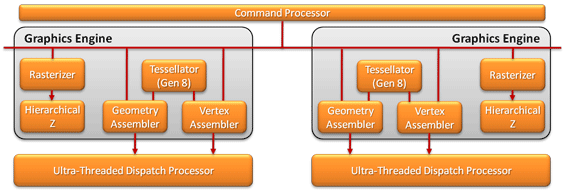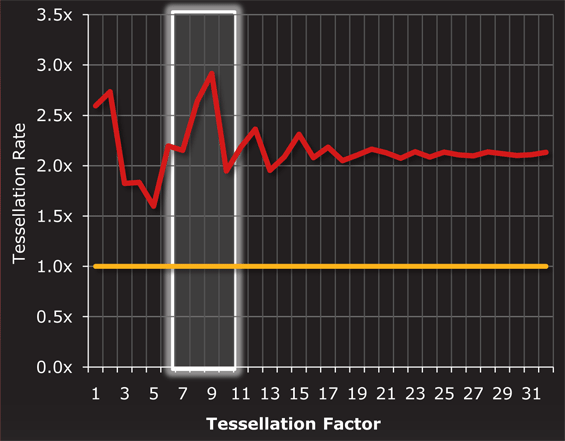AMD's Radeon HD 6970 & Radeon HD 6950: Paving The Future For AMD
by Ryan Smith on December 15, 2010 12:01 AM ESTAdvancing Primitives: Dual Graphics Engines & New ROPs
AMD has clearly taken NVIDIA’s comments on geometry performance to heart. Along with issuing their manifesto with the 6800 series, they’ve also been working on their own improvements for their geometry performance. As a result AMD’s fixed function Graphics Engine block is seeing some major improvements for Cayman.
Prior to Cypress, AMD had 1 graphics engine, which contained 1 each of the fundamental blocks: the rasterizers/hierarchical-Z units, the geometry/vertex assemblers, and the tessellator. With Cypress AMD added a 2nd rasterizer and 2nd hierarchical-Z unit, allowing them to set up 32 pixels per clock as opposed to 16 pixels per clock. However while AMD doubled part of the graphics engine, they did not double the entirety of it, meaning their primitive throughput rate was still 1 primitive/clock, a typical throughput rate even at the time.

Cypress's Graphics Engine
In 2010 with the launch of Fermi, NVIDIA raised the bar on primitive performance, with rasterization moved to NVIDIA’s GPCs, NVIDIA could theoretically push out as many primitives/clock as they had GPCs, in the case of GF100/GF110 pushing this to 4 primitives/clock, a simply massive improvement in geometry performance for a single generation.
With Cayman AMD is catching up with NVIDIA by increasing their own primitive throughput rate, though not by as much as NVIDIA did with Fermi. For Cayman the rest of the graphics engine is being fully duplicated – Cayman will have 2 separate graphics engines, each containing one fundamental block, and each capable of pushing out 1 primitive/clock. Between the two of them AMD’s maximum primitive throughput rate will now be 2 primitives/clock; half as much as NVIDIA but twice that of Cypress.

Cayman's Dual Graphics Engines
As was the case for NVIDIA, splitting up rasterization and tessellation is not a straightforward and easy task. For AMD this meant teaching the graphics engine how to do tile-based load balancing so that the workload being spread among the graphics engines is being kept as balanced as possible. Furthermore AMD believes they have an edge on NVIDIA when it comes to design - AMD can scale the number of eraphics engines at will, whereas NVIDIA has to work within the logical confines of their GPC/SM/SP ratios. This tidbit would seem to be particularly important for future products, when AMD looks to scale beyond 2 graphics engines.
At the end of the day all of this tinking with the graphics engines is necessary in order for AMD to further improve their tessellation performance. AMD’s 7th generation tessellator improved their performance at lower tessellation factors where the tessellator was the bottleneck, but at higher tessellation factors the graphics engine itself is the bottleneck as the graphics engine gets swamped with more incoming primitives than it can set up in a single clock. By having two graphics engines and a 2-primitive/clock rasterization rate, AMD is shifting the burden back away from the graphics engine.
Just having two 7th generation-like tessellators goes a long way towards improving AMD’s tessellation performance. However all of that geometry can still lead to a bottleneck at times, which means it needs to be stored somewhere until it can be processed. As AMD has not changed any cache sizes for Cayman, there’s the same amount of cache for potentially thrice as much geometry, so in order to keep things flowing that geometry has to go somewhere. That somewhere is the GPU’s RAM, or as AMD likes to put it, their “off-chip buffer.” Compared to cache access RAM is slow and hence this isn’t necessarily a desirable action, but it’s much, much better than stalling the pipeline entirely while the rasterizers clear out the backlog.

Red = 6970. Yellow = 5870
Overall, clock for clock tessellation performance is anywhere between 1.5x and 3x that of Cypress. In situations where AMD’s already improved tessellation performance at lower tessellation factors plays a part, AMD approaches 3x performance; while at around a factor of 5 the performance drops to near 1.5x. Elsewhere performance is around 2x that of Cypress, representing the doubling of graphics engines.
Tessellation also plays a factor in AMD’s other major gaming-related improvement: ROP performance. As tessellation produces many mini triangles, these triangles begin to choke the ROPs when performing MSAA. Although tessellation isn’t the only reason, it certainly plays a factor in AMD’s reasoning for improving their ROPs to improve MSAA performance.
The 32 ROPs (the same as Cypress) have been tweaked to speed up processing of certain types of values. In the case of both signed and unsigned normalized INT16s, these operations are now 2x faster. Meanwhile FP32 operations are now 2x to 4x faster depending on the scenario. Finally, similar to shader read ops for compute purposes, ROP write ops for graphics purposes can be coalesced, improving performance by requiring fewer operations.










168 Comments
View All Comments
Remon - Wednesday, December 15, 2010 - link
Seriously, are you using 10.10? It's not like the 10.11 have been out for a while. Oh, wait...They've been out for almost a month now. I'm not expecting you to use the 10.12, as these were released just 2 days ago, but you can't have an excuse about not using a month old drivers. Testing overclocked Nvidia cards against newly released cards, and now using older drivers. This site get's more biased with each release.
cyrusfox - Wednesday, December 15, 2010 - link
I could be wrong, but 10.11 didn't work with the 6800 series, so I would imagine 10.11 wasn't meant for the 6900 either. If that is the case, it makes total sense why they used 10.10(cause it was the most updated driver available when they reviewed.)I am still using 10.10e, thinking about updating to 10.12, but why bother, things are working great at the moment. I'll probably wait for 11. or 11.2.
Remon - Wednesday, December 15, 2010 - link
Nevermind, that's what you get when you read reviews early in the morning. The 10.10e was for the older AMD cards. Still, I can't understand the difference between this review and HardOCP's.flyck - Wednesday, December 15, 2010 - link
it doesn't. Anand has the same result for 25.. resolutions with max details AA and FSAA.Presentation on anand however is more focussed on 16x..10.. resolutions. (last graph) if you look in the first graph you'll notice the 6970/6950 performs like HardOcp. e.g. the higher the quality the smaller the gap becomes between 6950 and 570 and 6970 and 580. the lower the more 580 is running away and 6970/6950 are trailing the 570.
Gonemad - Wednesday, December 15, 2010 - link
Oookay, new card from the red competitor. Welcome aboard.But, all of this time, I had to ask: why is Crysis is so punitive on the graphics cards? I mean, it was released eons ago, and still can't be run with everything cranked up in a single card, if you want 60fps...
Is it sloppy coding? Does the game *really* looks better with all the eye candy? Or they built a "FPS bug" on purpose, some method of coding that was sure to torture any hardware that would be built in the next 18 months after release?
I will get slammed for this, but for instance, the water effects on Half Life 2 look great even on lower spec cards, once you turn all the eye-candy on, and the FPS doesn't drop that much. The same for some subtle HDR effects.
I guess I should see this game by myself and shut up about things I don't know. Yes, I enjoy some smooth gaming, but I wouldn't like to wait 2 years after release to run a game smoothly with everything cranked up.
Another one is Dirt 2, I played it with all the eye candy to the top, my 5870 dropped to 50-ish FPS (as per benchmarks),it could be noticed eventually. I turned one or two things off, checked if they were not missing after another run, and the in game FPS meter jumped to 70. Yay.
BrightCandle - Wednesday, December 15, 2010 - link
Crysis really does have some fabulous graphics. The amount of foliage in the forests is very high. Crysis kills cards because it really does push current hardware.I've got Dirt 2 and its not close in the level of detail. Its a decent looking game at times but its not a scratch on Crysis for the amount of stuff on screen. Half life 2 is also not bad looking but it still doesn't have the same amount of detail. The water might look good but its not as good as a PC game can look.
You should buy Crysis, its £9.99 on steam. Its not a good game IMO but it sure is pretty.
fausto412 - Wednesday, December 15, 2010 - link
yes...it's not much of a fun game but damn it is prettyAnnihilatorX - Wednesday, December 15, 2010 - link
Well original Crysis did push things too far and optimization could be used. Crysis Warhead is much better optimized while giving pretty identical visuals.fausto412 - Wednesday, December 15, 2010 - link
"I guess I should see this game by myself and shut up about things I don't know. Yes, I enjoy some smooth gaming, but I wouldn't like to wait 2 years after release to run a game smoothly with everything cranked up."that's probably a good idea. Crysis was made with future hardware in mind. It's like a freaking tech demo. Ahead of it's time and beaaaaaautiful. check it out on max settings,...then come back tell us what you think.
TimoKyyro - Wednesday, December 15, 2010 - link
Thank you for the SmallLuxGPU test. That really made me decide to get this card. I make 3D animations with Blender in Ubuntu so the only thing holding me back is the driver support. Do these cards work in Ubuntu? Is it possible for you to test if the Linux drivers work at the time?